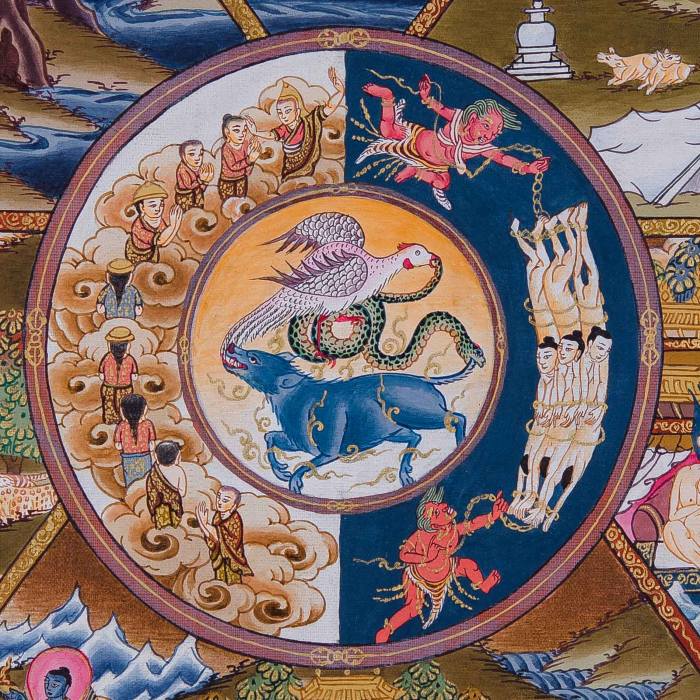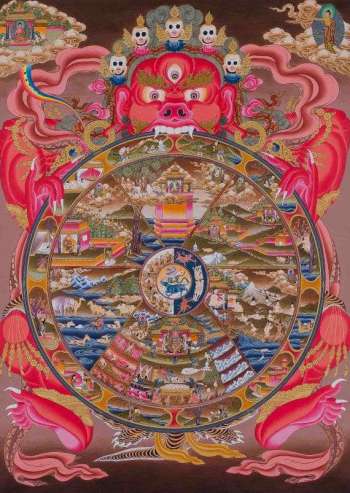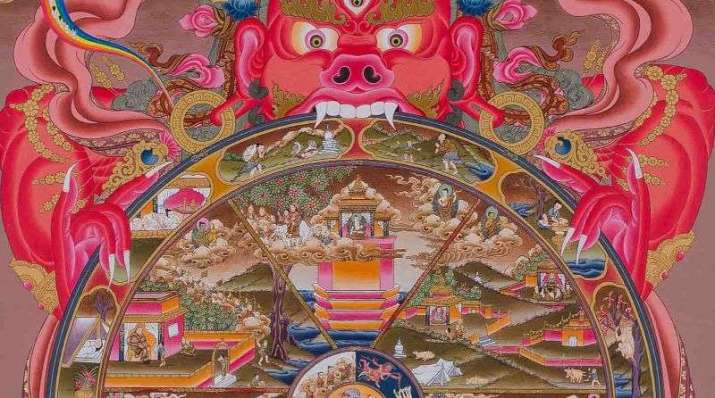Hatred is never appeased by hatred in this world. By non-hatred alone is hatred appeased. This is a law eternal. (Dhp. 5)
While the world is full of generosity and compassion, it is also surrounded by hatred. The Buddhist teachings introduce greed, hatred, and delusion as the three poisons or unwholesome roots of the mind. In the Wheel of Life, hatred is symbolized by a snake, together with a rooster and a pig, which respectively represent attachment and delusion. They are the driving forces behind the 12-factored formulation of dependent arising (Bodhi 2013), the six realms of rebirth, and existence in Saṃsāra.
While it may be quite challenging to comprehend the 12-factored formulation of dependent arising over a lifetime, and to fathom the nature of past and future lives, it is equally perplexing to visualize the six realms. Therefore, I usually invite students to contemplate these concepts from our present experience. For example, we could observe the arising and cessation of our mental processes when we meet a new friend. Before the contact, we could argue that this new friend does not exist in our experience. Of course, this new friend does exist from other people’s perspective, but not for us. It is like talking about the existence of a microbe without a microscope.

From thangka-mandala.com
It is through our sixfold sense base that we have contact with this new friend and this contact is conditioned upon our consciousness, mentality-materiality, which is further conditioned by kamma formations and ignorance. With contact, feeling arises, then craving, clinging, existence, birth, suffering, and so forth. It is important to note that feeling, craving, and clinging apply to both pleasurable or unpleasurable experiences. For humans, it is difficult to obstruct pleasant feelings toward an object or experience that we enjoy, or unpleasant feeling on an object or experience that we resent. For pleasant feelings, we tend to crave for more and cling on to them. For unpleasant feelings, we tend to push them away, reduce or repel them, or even resort to further volatile emotional or violent physical reactions. Both pleasant and unpleasant feelings could lead to attachments, leading to cycles of birth, aging, death, and rebirth.
Similarly, for the six realms of hell (Pali: Niraya), animals, hungry ghosts (Pali: peta), titans (Pali: asura), human beings, and devas. We may not know what hell really is, but we can observe the hellish pains of those who are mentally or physically unwell and how people in extreme poverty are deprived of basic needs. Of course, there are also well-blessed people in this world who enjoy much affluence and blessing like devas. There are also people who are in deep hatred and rivalry with one another, like the asuras, even though they are blessed with basic material needs. The key driving forces behind these six realms are still greed, hatred, and delusion, which are in turn deeply rooted in our physio-psychological mechanism.
 From thangka-mandala.com
From thangka-mandala.comAs Bodhi (1993) illustrates, consciousness rooted in hatred is of two kinds, according to Abhidhamma, distinguished as unprompted and prompted. This consciousness arises with only one kind of feeling of displeasure and, interestingly, does not arise in association with wrong view. Even though wrong view can motivate acts of hatred, it does not arise simultaneously with hate. Instead, it arises at an earlier time in a different type of citta (Pali. mind). Moreover, consciousness rooted in hatred is expounded under the synonymous term aversion (Pali: paṭigha). Paṭigha comprises a range of aversion from violent rage to subtle irritation.
Bodhi explains that the word paṭigha literally means “striking against,” which manifests a “mental attitude of resistance, rejection, or destruction.” To be clear, displeasure as an unpleasant feeling is different from aversion, which is the mental attitude of ill will or irritation. Displeasure is associated with aversion but it is included in the aggregate of feeling, whereas aversion belongs to the aggregate of mental formation.
Thanissaro (MN18) further analyzes that upon contact, our mind, driven by “perceptions and categories of papañca,” kicks off a process of thinking, desire or not desire, dear or not dear, which is followed by all the other mental formations of envy, stinginess, rivalry, and hostility. (DN21) Through this process of papañca or objectification, the need for an ontological support strengthens the delusion of a “self”—I think, therefore I am. In the modern era of social media, it seems increasingly obvious that people’s identities are created through their opinions, views, likes, or anger. Those who have no view seem to have neither identity nor presence. The unintended consequence is that the more extreme and exaggerated views and feelings are, the more viral the messages and the more prominent the individuals involved. Thanissaro (MN18) argues that one becomes a victim of his/her own patterns of thinking:
Based on what a person papañcizes, the perceptions & categories of papañca assail him/her with regard to past, present, & future forms cognizable via the eye [as with the remaining senses].
To interrupt this vicious cycle of thinking, the Buddha taught that we should shift our perception using categories of appropriate attention so that “unarisen fermentations* do not arise, and arisen fermentations are abandoned” by various practices of seeing, restraining, using, tolerating, avoiding, dispelling, and developing. (MN2) On the other hand, instead of falling into the habit of viewing feeling as appealing or unappealing, the Buddha (MN18) taught us to reflect on whether the pursuit of such a feeling is associated with an increase of skillful or unskillful qualities, and whether these feelings are refined.
By analyzing the cause-effect process of our mental proliferation, and the impact of such mental proliferation to our well-being, we could become less attached to (1) the object of perceptions and categories of papañca and (2) the subject “I” that feels and papañcizes. In the context of understanding hatred, the recommendation from the Buddha may suggest that we should similarly reflect on our feelings and mental processes. In response to peoples and events that strike against our feelings, our views, or even our identities, should we pursue these feelings? Would pursuing these feelings contribute to an increase of skillful or unskillful qualities in us? Would pursuing these feelings make us angrier or make us more compassionate? Can we learn from these feelings and better understand the origin of hatred and the origin of human suffering?
* In Pāli, mental defilements or fermentations are known as āsavas.
References
Bodhi, Bhikkhu (ed.) 1993. A Comprehensive Manual of Abhidhamma. Onalaska: Buddhist Publication Society.
Bodhi, Bhikkhu. 2013. “Transcendental Dependent Arising: A Translation and Exposition of the Upanisa Sutta”. Access to Insight (BCBS Edition), 1 December 2013, http://www.accesstoinsight.org/lib/authors/bodhi/wheel277.html
Buddharakkhita, Acharya (trans.). 2013. “Yamakavagga: Pairs” (Dhp 5). Access to Insight (BCBS Edition), 30 November 2013. http://www.accesstoinsight.org/tipitaka/kn/dhp/dhp.01.budd.html
Thanissaro, Bhikkhu (trans.). 2013. “Madhupindika Sutta: The Ball of Honey” (MN 18). Access to Insight (BCBS Edition), 30 November 2013, http://www.accesstoinsight.org/tipitaka/mn/mn.018.than.html
Thanissaro, Bhikkhu (trans.). “Sabbasava Sutta: All the Fermentations” (MN 2). Access to Insight (BCBS Edition), 30 November 2013, http://www.accesstoinsight.org/tipitaka/mn/mn.002.than.html
Thanissaro, Bhikkhu (trans.). 2013. “Sakka-pañha Sutta: Sakka's Questions” (DN 21). Access to Insight (BCBS Edition), 30 November 2013. http://www.accesstoinsight.org/tipitaka/dn/dn.21.2x.than.html
See more
The Thirty-one Planes of Existence (Access to Insight)
Related features from Buddhistdoor Global
Cultivating True Friendship in the Age of Social Dilemma
Would the Buddha Be on Facebook?
The Path of Practice in our Digital Age
Transformative Technology as the Path Forward for Humanity
The Wisdom of Grief and Anxiety – Building a Life of Meaning Outside of the Social Media Trap
Shifting Trust in the Age of Fakery
Buddhistdoor View: “Hyper-mindfulness”—An Urgent Buddhist Response to the Age of Social Media
The Unskillful Use of Social Media
More from Mindful Capital By Ernest Chi-Hin Ng

















